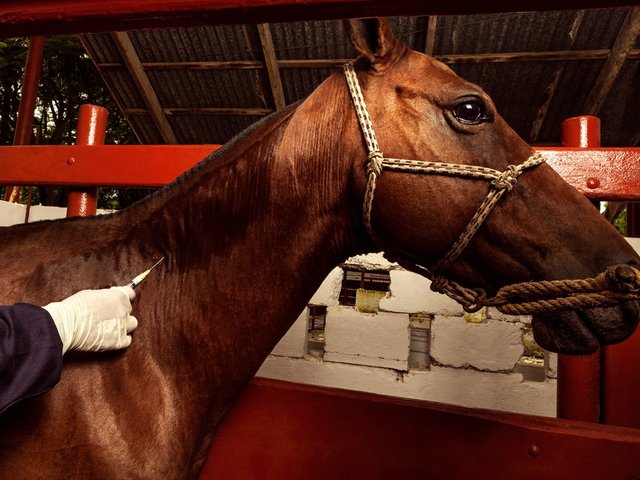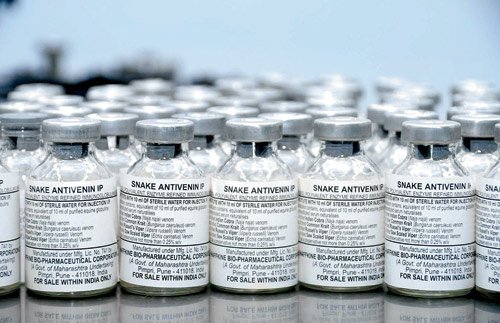How Is Snake Antivenom Actually Produced?
You've probably seen videos (or at least photos) of herpetologists harvesting snake venom (if you haven't, I've post one below). Often referred to as "milking" venomous snakes, many labs and reptile keepers around the world collect snake venom for one very important reason: the production of snake antivenom. Antivenoms are pharmaceutical products made up of venom neutralizing antibodies, are are administered in the event of a snake bite to mitigate the damage of tissues and save lives. Many of you probably already know this, but perhaps you do not know how the antivenom is produced; how do you go from a cup of raw snake venom to a powerful pharmaceutical product that saves thousands of lives annually?
Earlier today, @steemmatt asked me some fantastic questions.
Let's say you get bitten by a venomous snake, but it doesn't kill you (or the animal)... How long does the venom typically stay in the bloodstream without anti-venom/treatment? Does it eventually get purged out?
In order to understand how antivenom is produced, you have to be familiar with the body's response to envenomation. So let's imagine you have been bitten by a venomous snake; there's intense pain and the destruction of tissues around the wound is well underway. As the venom moves through the body, your immune system is not passively accepting it, it is preparing a defense. Your own body will begin producing antibodies that will combat the venom and its destructive spread. However, humans (and primates in general) did not evolve much in the way of developing toxin resistances; the antibodies can take a long time to produce and are not incredibly effective. This is why venomous bites can still be lethal; they kill far too quickly for the body to produce the necessary antibodies to defeat it. However, let's say you were bitten by a copperhead (the one native to US, not the deadly species in Australia!). The copperhead's venom is actually quite mild, one of the weakest out there. When admitted to a hospital, treatment for a copperhead bite is generally just a few painkillers; the venom is weak enough that the body's production of antibodies can fight it off. How long it remains in the body is dependent on the potency of the venom, how it affects the victim's body, and the strength of the defending immune system.

So, our snake expert begins the production process by milking a venomous snake. To do so, he has the snake bite down on a venom-capture jar, during which he massages the areas around the venom glands, encouraging the snake to inject more into the collection jar. The snake is then removed and returned to its enclosure, where it will being producing more soon-to-be-lifesaving venom. The keeper now has a jar of venom, but obviously this is far from a finished product. Check out this video to see what happens when the venom is combined with blood (mildly graphic content!).
Yikes! Obviously we can't be putting that into a person, it will only make things much worse! However, the venom will be injected into something else: livestock such as horses and sheep are crucial to the production of antivenom. Don't panic or get enraged about inhumane treatment just yet though! Only trace quantities of the venom are introduced into these animals; quantities so small, the can't cause any damage or even discomfort. The animals remain completely healthy and most likely don't even realize what is happening. The minute amount of venom in their bodies does trigger an immune reaction though, the same reaction as our own: the body begins producing antibodies to fight off the venom and protect the animal. The process creates an immunological response that produces large numbers of neutralizing antibodies against various components of the venom.

During certain intervals of the process, some blood is collected from the animal (again, not so often that it negatively affects their health or wellbeing; production is regulated by the USDA and FDA). The antibodies that have been produced are then purified from the blood to produce the final antivenin.

It is this antivenom that is administered when a patient arrives at the hospital. However, while antivenom can be the crucial difference between life and death, there is a risk when using it. Because the antibodies within are those of other donor species, human can have life-threatening allergic reactions. For this reason, antivenom is generally not administered unless there is no other option, generally in the case of extremely potent envenomation or the patient has a compromised immune system. Referring back to the copperhead, antivenom is rarely administered as the damage caused by an allergic reaction could be far worse than that caused by the venom itself! However, despite the risks and the dangers, antivenom works. We have harnessed the capabilities of other species' antibodies to neutralize venom within our own bodies.

That's super cool! I hadn't really thought of the role of the immune system in dealing with toxins before, rather than just invasive organisms. In retrospect, though, it makes a ton of sense!
Post of the day.go ahead bro.best of luck
black mamba is very dengares snake ,,,,amazing pic bro,,,.
I knew venom could be a neurotoxin but not a blood coagulant, too! Very interesting! Thanks for sharing!